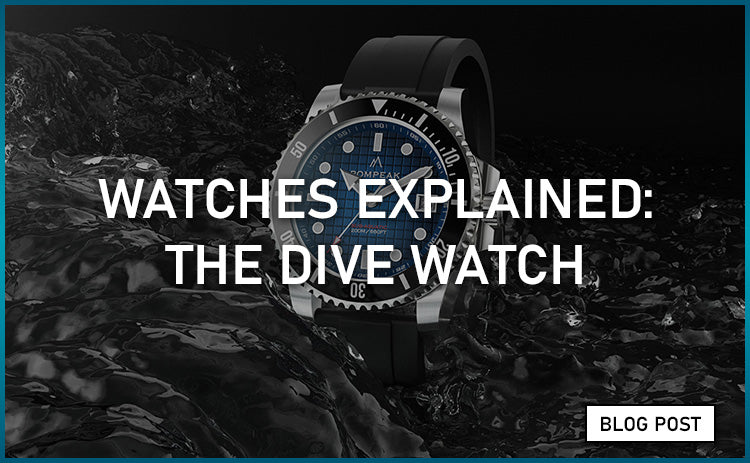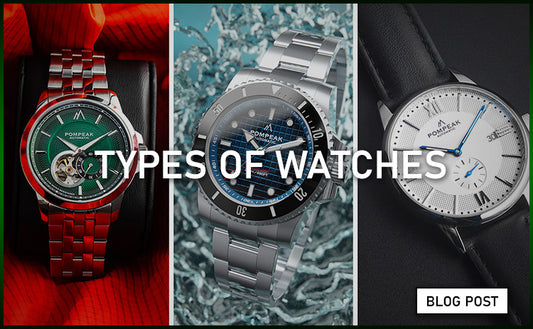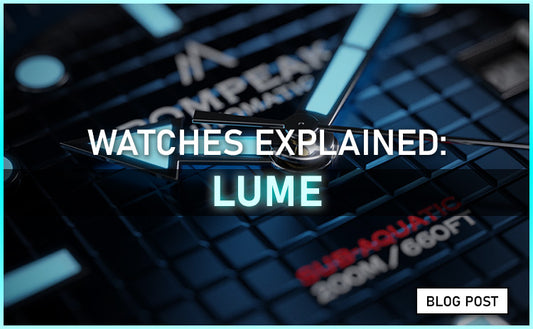
Watches Explained: The Dive Watch
Share
The dive watch. Originating from timepieces created for explorers, this style of watch has become one of, if not the, most defining available. Every brand has their signature piece – Rolex has the Submariner, Omega has the Seamaster and now Pompeak has the Sub-Aquatic.
To coincide with the release of our latest collection we’d thought now would be a good time to remind ourselves why dive watches are so iconic.

The Sub-Aquatic
What is a dive watch?
A dive watch is, predictably, a watch designed for underwater diving, with a minimum water resistance of 10ATM (static water pressure equivalent of 100m).

The International Organization for Standardization has minimum requirements when recognising a 'Divers watch' (ISO 6425):
- Minimum water resistance of 10ATM.
- Equipped with a diving time indicator (usually a rotating bezel).
- Clearly distinguishable minute markings on the watch face.
- Adequate readability/visibility at 25 cm (9.8 in) in total darkness.
- The presence of an indication that the watch is running in total darkness (usually indicated by a running second hand with a luminous tip).
- Magnetic resistance - tested by 3 exposures to a direct current magnetic field of 4,800 A/m. To pass, the watch must keep its accuracy to ± 30 seconds/day as measured before the test.
- Shock resistance - tested by two shocks one on the 9 o'clock side, and one to the watch crystal. Acceptable accuracy change is ± 60 seconds/day.
- Chemical resistance - tested by immersion in a 30 g/l NaCl solution (replicates seawater) for 24 hours to test rust resistance.
- Strap/band solidity - tested by applying a force to each spring bar (or attaching point) in opposite directions with no damage to the watch or attachment point.
- The presence of an End of Life indicator on battery powered watches.
Now, while relevant and recognised certifications are great, let's be honest - with technology where it is today, it's rare that mechanical watches are used as the primary life preserving tool over modern dive computers when scuba diving.
It's for this reason that more and more brands (Pompeak included) are choosing not to put their products through ISO certification even though they are up to scratch.
The Sub-Aquatic, for example, meets all of the practical requirements (and then some), but the added cost of certification just wouldn't be worth the necessary increase in retail price.

That said, if you are shopping for a dive watch, ISO rated or not, be sure to check the specs and make sure you can actually take your watch in the water!
A brief history
Efforts to produce water-resistant watches date back to the 17th century, although real success wouldn't occur until the 19th century with aptly named “Explorer’s Watches, produced with basic levels of water and dust resistance.
Rolex made the first notable breakthrough, patenting its famous “Oyster” watch case in 1926, featuring a hermetic (air tight) seal capable of surviving more than 10 hours in seawater - proven by Mercedes Gleitze in her 1927 English Channel swim.

Gleitze beginning her successful attempt as the first woman to swim the English Channel.
The first commercially produced diving watch was created by Omega in 1932 - Named 'The marine', this watch featured a double cased design sealed with cork capable of withstanding depth up to 135m (443ft).

The addition of lume was first incorporated in a Rolex based Panerai in 1936 following a request by the Italian Royal Navy to improve visibility.

The next 25 years saw little developments in diving watch technology until 1961 when both Edox and Rolex released pieces rated up to 200 metres. (Shortly followed by the release “ultra-water resistant” watches such as the Rolex Sea-Dweller rated up to 600 metres).
The improvement of the Submariner’s water-resistance helped it become the watch of choice for the first ten James Bond films, which in turn helped it achieve icon status.

Sean Connery as James Bond in Goldfinger.
Fast forward 20 years to the 80’s and you'll meet the introduction of digital dive watches, and to the present day where most, if not all, serious divers are accompanied by dive computers. These electronic devices measure the time and depth of each dive, assisting with oxygen management and ascent, helping divers avoid decompression sickness.

Classic mechanical dive watches are often worn as backup instruments in the event of a computer malfunction.
Materials
Dive watches, and their straps, can be made from a range of materials, with the more serious pieces coming equipped with corrosion-resistant properties. 316L stainless steel, commonly referred to as “surgical grade”, is resistant to corrosion, acid and chlorides which makes it ideal for surgical instruments (hence the name) as well as most 'daily wear' watches.
Although resilient, 316L is susceptible to corrosion when exposed to prolonged periods in salty seawater. This is where 904L stainless steel comes in.
An increase in Nickel, Chromium and Molybdenum gives 904L steel a far superior resistance to chlorides and acids making it perfect for any type of diving. This, along with the highly polished finish achievable, is why 904L is championed by Rolex in their 3,900m rated Deepsea range.

904L Stainless steel - A corrosion resistant super alloy
When it comes to dive watch straps, there are 3 main categories: metallic, rubber and NATO (you don't want to be taking leather straps underwater). Metallic bracelets are usually fashioned from the same material as the watch case, rubber is flexible, yet strong and easily cleaned, while NATO straps are made from naturally tough nylon which gives a military like look.

The Sub-Aquatic strap variations
What all these straps have in common is their ability to be quickly, and securely, fitted to either the wrist or over a scuba suit. NATO and rubber straps are usually adjusted by the classic tang buckle, while some higher end metallic bands come with a sliding clasp.
Versatility
Designed to be used within the harsh world beneath the waves, dive watches are extremely tough and more than capable of surviving anything land based life can thrown at it - Whether that be dirt, sand, magnetism or regular knocks, a well built dive watch will keep ticking through it all.

You may find some dive capable watches categorised under their initial concept as “Explorer’s Watches”
The versatility bleeds through to the watches style where a simple strap change can completely transform the entire look of the dive watch.
From the red carpet to the wrist of a high flying CEO, the dive watch has become a versatile fashion accessory, and its unique look is loved by many.
The suave, sophistication of decades of Bond sporting this iconic watch right from high stakes poker to jaw-dropping action made an impression on audiences at all corners of the world and helped cement the idea that dive watches may just be the most versatile watch you can wear just about anywhere, doing just about anything.

Sean Connery's James Bond influenced a generation.
We say this often but a good quality watch should last a lifetime, and none can do it quite as comfortably as a dive watch.





